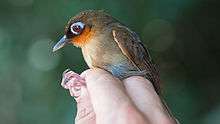Rufous-throated antbird
The rufous-throated antbird (Gymnopithys rufigula) is a species of bird in the family Thamnophilidae. It is found in Brazil, French Guiana, Guyana, Suriname, and Venezuela. Its natural habitat is subtropical or tropical moist lowland forests.
| Rufous-throated antbird | |
|---|---|
 | |
| Scientific classification | |
| Kingdom: | Animalia |
| Phylum: | Chordata |
| Class: | Aves |
| Order: | Passeriformes |
| Family: | Thamnophilidae |
| Genus: | Gymnopithys |
| Species: | G. rufigula |
| Binomial name | |
| Gymnopithys rufigula (Boddaert, 1783) | |
Taxonomy
The rufous-throated antbird was described by the French polymath Georges-Louis Leclerc, Comte de Buffon in 1775 in his Histoire Naturelle des Oiseaux from a specimen collected in Cayenne, French Guiana.[2] The bird was also illustrated in a hand-coloured plate engraved by François-Nicolas Martinet in the Planches Enluminées D'Histoire Naturelle which was produced under the supervision of Edme-Louis Daubenton to accompany Buffon's text.[3] Neither the plate caption nor Buffon's description included a scientific name but in 1783 the Dutch naturalist Pieter Boddaert coined the binomial name Turdus rufigula in his catalogue of the Planches Enluminées.[4] The rufous-throated antbird is now placed in the genus Gymnopithys was introduced by the French ornithologist Charles Lucien Bonaparte in 1857 with the rufous-throated antbird as the type species.[5][6] The name Gymnopithys combines the Ancient Greek gumnos meaning "bare" or "naked" with the name of the antbird genus Pithys that was erected by the French ornithologist Louis Jean Pierre Vieillot in 1818. The specific epithet rufigula combines the Latin words rufus "red" and gula "throat".[7]
Three subspecies are recognised:[6]
- G. r. pallidus (Cherrie, 1909) – south Venezuela
- G. r. pallidigula Phelps & Phelps Jr, 1947 – tepuis of extreme southwest Venezuela
- G. r. rufigula (Boddaert, 1783) – east Venezuela, the Guianas and northeast Brazil
References
- BirdLife International (2012). "Gymnopithys rufigula". IUCN Red List of Threatened Species. 2012. Retrieved 26 November 2013.CS1 maint: ref=harv (link)
- Buffon, Georges-Louis Leclerc de (1775). "Le Merle Roux de Cayenne". Histoire Naturelle des Oiseaux (in French). Volume 6. Paris: De L'Imprimerie Royale. pp. 105–106.
- Buffon, Georges-Louis Leclerc de; Martinet, François-Nicolas; Daubenton, Edme-Louis; Daubenton, Louis-Jean-Marie (1765–1783). "Petit merle brun à gorge rousse de Cayenne". Planches Enluminées D'Histoire Naturelle. Volume 7. Paris: De L'Imprimerie Royale. Plate 644 fig. 2.
- Boddaert, Pieter (1783). Table des Planches Enluminéez d'Histoire Naturelle, de M. d'Aubenton. Avec les denominations de M.M. de Buffon, Brisson, Edwards, Linnaeus et Latham, precédé d'une Notice des Principaux Ouvrages Zoologiques enluminées. Utrecht: Boddaert. p. 39, Plate 644 fig. 2.
- Bonaparte, Charles Lucien (1857). "Catalogue des oiseaux recuellis a Cayenne". Bulletin de la Société linnéenne de Normandie (in French). 2: 29–40 [35].
- Gill, Frank; Donsker, David, eds. (2018). "Antbirds". World Bird List Version 8.1. International Ornithologists' Union. Retrieved 16 March 2018.
- Jobling, James A. (2010). The Helm Dictionary of Scientific Bird Names. London: Christopher Helm. pp. 182, 342. ISBN 978-1-4081-2501-4.
Further reading
- Oniki, Yoshika (1971). "Parental care and nesting in the rufous-throated antbird, Gymnopithys rufigula, in Amapá, Brazil" (PDF). Wilson Bulletin. 83 (4): 347–351.
